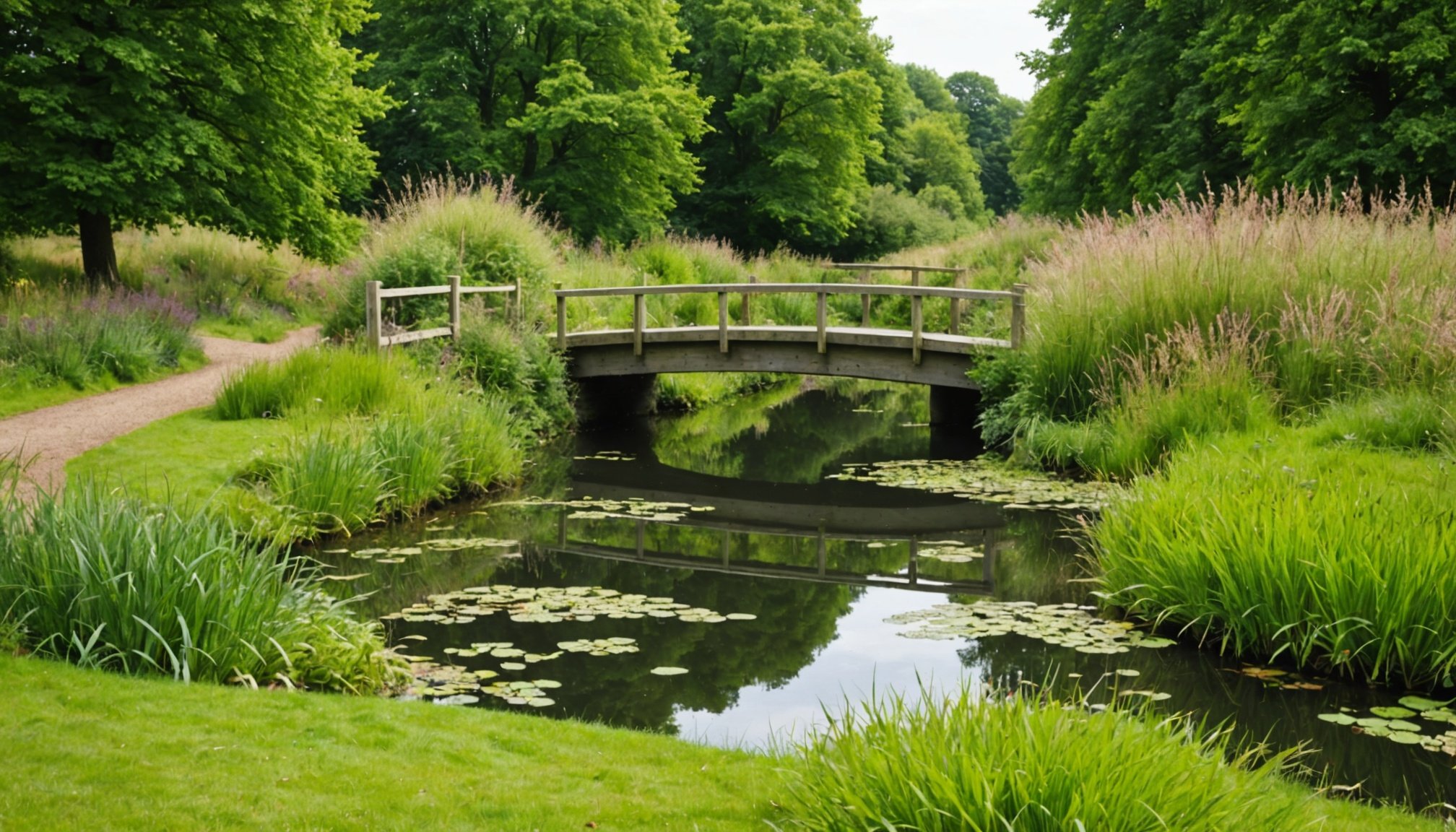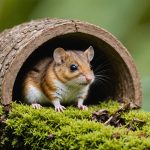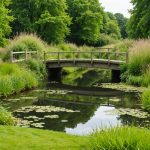Importance of Urban Green Spaces for Amphibians
Urban green spaces are vital in promoting biodiversity, specifically by providing essential habitats for various species, including amphibians. Cities often pose challenges for wildlife, making the preservation and development of these spaces crucial. Urban green spaces serve as sanctuaries, offering amphibians a refuge amid bustling city life. Their importance extends beyond simple aesthetics to encompass ecological functions that benefit the entire urban ecosystem.
Amphibians play a critical role in these ecosystems by acting as bioindicators. Their presence and health provide valuable insights into the state of the environment. These species help maintain ecological balance by aiding in pest control and serving as key components of the food web. Therefore, preserving and enhancing amphibian habitats within cities is necessary for a diverse and healthy ecosystem.
Avez-vous vu cela : Navigating Beaver-Human Conflicts: Innovative Strategies by UK Conservationists
Unfortunately, habitat loss is one of the significant threats facing amphibian populations in urban areas. As cities expand, natural environments are often fragmented or destroyed, leaving amphibians with limited living spaces. Implementing ecological design in urban planning can create interconnected habitats that cater to these species’ needs, boosting their chances of survival and supporting urban biodiversity.
Guidelines for Designing Supportive Urban Green Spaces
Creating urban green spaces requires careful urban planning and design guidelines to ensure they support biodiversity and habitat enhancement. Such spaces offer refuge and resources for various species.
A lire également : Transform Your Garden into a Dormouse Sanctuary: A Guide for UK Residents to Support Endangered Species
Selecting Appropriate Plant Species
Choosing the right plant species is vital. Focusing on native species that bolster local biodiversity is essential. Native plants like wildflowers, shrubs, and trees are adapted to the local climate and soil conditions. They provide food and shelter for local wildlife, essential for their survival and reproduction. By integrating a variety of native species, urban planners can create a rich tapestry of habitats that supports insects, birds, and small mammals.
Creating Water Features
Water features are instrumental for breeding and movement. Pond ecosystems, streams, or rain gardens can greatly enhance the ecological value of an urban green space. They provide habitats for aquatic organisms and act as watering holes for other wildlife. Ensuring these water bodies are equipped with natural edges and are kept clean benefits both biodiversity and the human experience of these areas.
Designing Natural Shelter Areas
Incorporating elements like logs, rocks, and dense vegetation can create natural shelter areas. These features mimic natural habitats, offering refuge and breeding grounds. By arranging these elements thoughtfully, green spaces become inviting sanctuaries for wildlife, supporting a rich urban ecosystem.
Best Practices and Strategies
Creating a harmonious balance between human development and ecological preservation requires meticulous planning. In landscape architecture, the use of best practices is essential for sustainable development. One effective approach is integrating green corridors. These corridors connect fragmented habitats, allowing species to migrate and thrive despite urban environments. This strategy not only supports biodiversity but also enhances the aesthetic and recreational value of urban spaces.
Incorporating sustainable design principles is another critical aspect. Techniques such as rainwater harvesting, native plantings, and xeriscaping reduce water consumption and promote a resilient ecosystem. By focusing on the right combination of flora suitable for the local climate, landscape architects can design spaces that demand minimal resources while offering maximum ecological benefits.
Furthermore, balancing human use and wildlife needs is pivotal. Providing designated pathways for humans can minimise disturbances to natural habitats, ensuring wildlife can access critical resources safely. These pathways not only protect wildlife but also educate and sensitize the public regarding the importance of preserving natural ecosystems.
By consistently applying these strategies, landscape architects can shape environments that are not only sustainable but also beneficial to both humans and wildlife.
Case Studies of Successful Urban Green Spaces in the UK
Examining urban biodiversity projects across the UK offers valuable insights into effective habitat creation that combines nature with urban life.
Project Overview
One renowned urban biodiversity project focuses on amphibian conservation, addressing the needs of these delicate species within city environments. Initiatives have included the restoration of wetlands and the creation of amphibian corridors, enabling safe migration. These projects are designed to improve local ecology while also increasing public awareness and involvement.
Key Features
Projects focus on specific design elements tailored to amphibian needs, like maintaining appropriate water quality and vegetation that provides both food and shelter. Creating microhabitats within urban parks and maintaining natural water cycles are critical. These design features ensure the conservation of local species and enrich the urban biodiversity matrix.
Outcomes and Impact
The success of these projects is measured by ecological improvements and community engagement. Positive outcomes include increased amphibian populations and heightened public interest in conservation. Engaging the community through educational programs and volunteer opportunities enhances long-term sustainability. Ultimately, these initiatives not only bolster urban biodiversity but also foster a community that values ecological health and conservation efforts.
Ecological Principles Underpinning Urban Design
Understanding the ecological principles that shape urban design is vital in fostering sustainable cities. The integration of landscape ecology principles allows urban planners to maintain and enhance biodiversity. By appreciating how urban ecosystems function, cities can support diverse plant and animal life, while also catering to human needs.
Urban Ecosystems and Their Functions
Urban ecosystems, dynamic and multifaceted, are ecosystems influenced by human activities. They require a balance between green space development and human infrastructure to maintain ecosystem services such as air purification and temperature regulation. Embracing ecological literacy enables planners to make informed decisions that benefit both nature and city dwellers.
Principles of Landscape Connectivity and Fragmentation
One key principle in urban design is ensuring landscape connectivity, crucial for allowing species to migrate and interact. Conversely, minimizing fragmentation—a result of urban sprawl—prevents habitat isolation and loss of species. Designing green corridors and networks helps create a continuous habitat for urban wildlife, promoting ecological stability.
Importance of Ecological Literacy in Urban Planning
As cities grow, integrating ecological literacy into urban planning becomes increasingly essential. It equips urban designers with the knowledge to incorporate natural features and processes into urban environments, which enhances biodiversity. This approach not only conserves nature but also improves residents’ quality of life by creating more resilient urban landscapes.
Challenges and Solutions in Urban Green Space Design
Urban green space design faces numerous challenges, particularly in densely populated areas where urban development pressures mount. These spaces must balance the need for ecosystem preservation while accommodating human activities.
Identifying Common Barriers
One primary obstacle is the potential conflict between urban development and biodiversity preservation. As cities expand, natural habitats face fragmentation, leading to biodiversity loss. Additionally, integrating green spaces without disrupting existing city infrastructure poses a significant hurdle. Urban planners often struggle with limited land availability and competing interests, such as housing needs versus recreational areas.
Innovative Solutions
Innovative practices from other regions suggest that multi-functional spaces can harmonise urban landscapes and biodiversity goals. For instance, the implementation of green roofs and walls has gained traction, offering vertical gardens that don’t consume excessive space. Also, biophilic design, which integrates nature into built environments, can enhance urban green spaces while promoting biodiversity.
Policy and Regulatory Considerations
Understanding local policies is crucial as it influences design choices and conflict resolution. Policies that prioritise green space can support sustainable urban development by mandating minimum green areas in new projects. Moreover, collaboration between government bodies and community stakeholders is vital for creating policies that reflect both ecological and social imperatives.
By addressing these barriers and employing innovative solutions, urban green spaces can thrive amid development pressures.
Role of Community Engagement in Urban Green Spaces
Engaging local communities in the development and maintenance of urban green spaces is crucial for their success and sustainability. Public participation ensures that these areas meet the needs and desires of those who use them most. When communities are involved in the design process, they are more likely to take ownership, fostering a sense of responsibility and pride.
Furthermore, educational programs play an essential role in raising awareness about issues such as amphibian conservation and broader environmental efforts. These programs not only educate but inspire action, creating a ripple effect of positive change within the community. Collaborative efforts, such as workshops or guided tours, encourage residents of all ages to learn about the local ecosystem and contribute to its preservation.
Success stories of community-led urban projects highlight the power of public participation. In numerous cities, grassroots initiatives have transformed neglected spaces into thriving ecosystems, showcasing the ingenuity and dedication of local residents. These examples serve as models for similar projects, demonstrating how effective community engagement can build momentum for broader urban transformation.
Through community involvement and strategic educational programs, urban green spaces can become vibrant hubs of biodiversity and community connection, fostering an environment that benefits both people and wildlife.
Future Directions for Urban Green Space Design
Over the past few years, future trends in urban green space design have leaned toward enhancing urban resilience and fostering biodiversity. As cities face challenges such as climate change and population growth, innovative design practices are crucial.
Emerging Trends in Urban Biodiversity and Design
One prominent trend is the integration of biodiversity strategies into urban planning. This includes creating green corridors that connect fragmented habitats, ensuring wildlife can thrive amidst urban development. Incorporating native plant species within parks and gardens not only preserves local ecosystems but also promotes species diversity.
Role of Climate Resilience in Future Planning
Climate resilience plays a pivotal role in shaping future urban designs. Planners are now prioritising green spaces that can withstand extreme weather events. For instance, rain gardens and permeable surfaces are being used to manage stormwater and reduce urban flooding risks. These elements not only enhance the aesthetic appeal of urban areas but also serve practical purposes.
Long-term Strategies for Maintaining and Enhancing Habitats
Future design also involves long-term strategies for sustaining urban green spaces. This includes regular monitoring and adaptive management practices that ensure these habitats continue to flourish. Collaborating with ecologists and local communities helps maintain biodiversity and keeps urban areas vibrant and sustainable.











